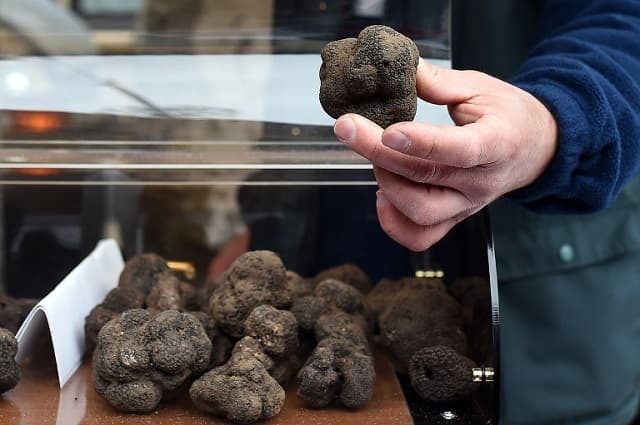Italy's earthquake-hit towns are bidding for Unesco status

Italy will be putting forward two bids for Unesco World Heritage status from the central Italian region devastated by recent earthquakes, the national Unesco committee said on Monday.
In the running for the prestigious recognition are the 'truffle culture' of Norcia, Umbria, which was one of the worst hit towns in last year's quakes, and a religious festival from l'Aquila, a town still recovering from a deadly tremblor in 2009.
Before the earthquake, Norcia was a town little known outside Italy, except among in-the-know foodies, who celebrated it for its ham and truffles as well as the picturesque scenery.
The regional councillor for Culture and Tourism, Antonella Parigi, said Monday's announcement was "great news for one of the excellent products of our territory".
Black truffles thrive in Norcia's hills and warm climate, and the 'black diamonds' are celebrated in the town's annual fair, Nero Norcia.
Comprising markets, tastings and other events revolving around the truffles and other local culinary produce, the fair dates back more than 60 years. Prime Minister Paolo Gentiloni attended the 2017 edition, which went ahead despite ongoing recovery efforts in the town.
According to figures from agricultural organization Coldiretti, the region's truffle industry is worth half a billion euros annually.
However, the series of earthquakes in 2016 left the town's agricultural sector suffering from huge losses of revenue and livestock.
Italy's Unesco committee unanimously voted in favour of submitting the bid from Norcia, along with one from nearby l'Aquila.
L'Aquila is seeking Unesco recognition for its Perdonanza Celestiniana festival; a historic tradition which commemorates Pope Celestine V granting an indulgence to pilgrims visiting the Santa Maria di Collemaggio church on the anniversary of his papal coronation.
The pope's body is still kept at the basilica, with some saying the fact his remains were undamaged by the quake was a 'miracle'.
The two bids have been submitted to the Unesco committee in Paris, where they will be reviewed by the end of 2018, with a decision expected the following year.
Italy already boasts more Unesco heritage sites than any other country, with 51 to its name - a number so high that it didn't bother to bid for any more last year, to give other countries a chance to catch up.
READ ALSO: Five Italian Unesco sites you won't have heard of

Photo: Pit56/Flickr
Its heritage sites range from entire cities such as Florence and Venice, to cathedrals, castles and ancient ruins.
In 2016, Italy announced it had prepared a dossier to get Neapolitan pizza added to Unesco's Intangible Cultural Heritage List, and earlier this year, it announced a bid to get Unesco status for its Prosecco hills, where the famous drink is made.
READ ALSO: Why Italy wants Unesco status for its Prosecco hills

Photo: Vincenzo Pinto/AFP
Comments
See Also
In the running for the prestigious recognition are the 'truffle culture' of Norcia, Umbria, which was one of the worst hit towns in last year's quakes, and a religious festival from l'Aquila, a town still recovering from a deadly tremblor in 2009.
Before the earthquake, Norcia was a town little known outside Italy, except among in-the-know foodies, who celebrated it for its ham and truffles as well as the picturesque scenery.
The regional councillor for Culture and Tourism, Antonella Parigi, said Monday's announcement was "great news for one of the excellent products of our territory".
Black truffles thrive in Norcia's hills and warm climate, and the 'black diamonds' are celebrated in the town's annual fair, Nero Norcia.
Comprising markets, tastings and other events revolving around the truffles and other local culinary produce, the fair dates back more than 60 years. Prime Minister Paolo Gentiloni attended the 2017 edition, which went ahead despite ongoing recovery efforts in the town.
According to figures from agricultural organization Coldiretti, the region's truffle industry is worth half a billion euros annually.
However, the series of earthquakes in 2016 left the town's agricultural sector suffering from huge losses of revenue and livestock.
Italy's Unesco committee unanimously voted in favour of submitting the bid from Norcia, along with one from nearby l'Aquila.
L'Aquila is seeking Unesco recognition for its Perdonanza Celestiniana festival; a historic tradition which commemorates Pope Celestine V granting an indulgence to pilgrims visiting the Santa Maria di Collemaggio church on the anniversary of his papal coronation.
The pope's body is still kept at the basilica, with some saying the fact his remains were undamaged by the quake was a 'miracle'.
The two bids have been submitted to the Unesco committee in Paris, where they will be reviewed by the end of 2018, with a decision expected the following year.
Italy already boasts more Unesco heritage sites than any other country, with 51 to its name - a number so high that it didn't bother to bid for any more last year, to give other countries a chance to catch up.
READ ALSO: Five Italian Unesco sites you won't have heard of

Photo: Pit56/Flickr
Its heritage sites range from entire cities such as Florence and Venice, to cathedrals, castles and ancient ruins.
In 2016, Italy announced it had prepared a dossier to get Neapolitan pizza added to Unesco's Intangible Cultural Heritage List, and earlier this year, it announced a bid to get Unesco status for its Prosecco hills, where the famous drink is made.
READ ALSO: Why Italy wants Unesco status for its Prosecco hills

Photo: Vincenzo Pinto/AFP
Join the conversation in our comments section below. Share your own views and experience and if you have a question or suggestion for our journalists then email us at [email protected].
Please keep comments civil, constructive and on topic – and make sure to read our terms of use before getting involved.
Please log in here to leave a comment.